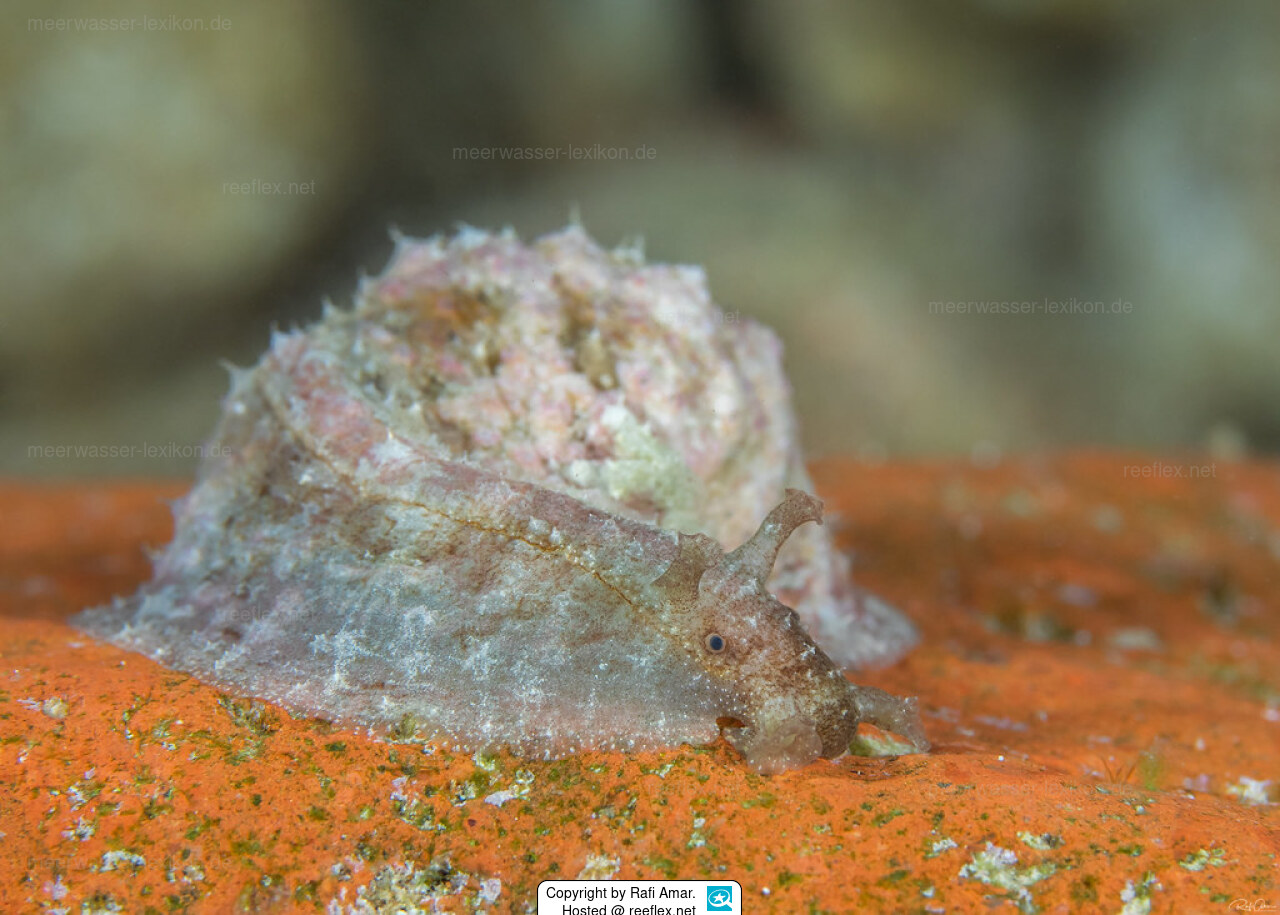Info
Dolabrifera dolabrifera (Rang, 1828)
It is a flattened seahare with parapodia fitting snugly to the body and two small openings on the back. The rhinophores and head tentacles are small and variously mottled in brown, red, and olive green. On the notum are short, sometimes branching, papillae.
Natural History: Dolabrifera dolabrifera is a common species found in tide and ebb pools in rocky areas. It occurs in exposed sheltered spots. It is a nocturnal lumpfish that lays masses of eggs consisting of a flattened egg thread attached to the bottom of a rock in a tight zigzag pattern.
Sea hares feed on algae. They eat various types of algae, kelp and seaweed. In the process, plant parts are rasped off with the rasping tongue (radula). Microscopic food particles are also ingested with the algae. They are often used in aquaristics for algae problems, but with the end of their food they also get nutritional problems.
For protection against predators there are some species that additionally store the toxin aplysiatoxin. This aplysiatoxin is a product of cyanobacteria, which grow on certain types of seaweed. These are ingested along with the algae.
Sea hares are good algae eaters after a usually difficult acclimation period and are also not very picky about the algae. When acclimating, be sure to use the droplet method, as they are extremely sensitive to density fluctuations.
Thus, in addition to the usual filamentous algae, Wrangelia argus and so-called smear algae are often not spurned.
If no more algae are present, then it does not take long and the ea hare starves to death.
However, you can also offer it over-scalded lettuce as a substitute food, but then you should also looka for a substitute home.
Attention, important:
If you want to keep a sea hare, be sure to provide shelter so they don't get caught in a flow pump and shredded.
Dying sea hares are capable of causing the entire fish and crustacean population to die within a short period of time.
If the dead sea hare is not discovered in time, it is imperative to perform a very generous water change and additionally filter with charcoal to filter out the released toxins
Synonymised names:
Aplysia dolabrifera Rang, 1828 · unaccepted (original combination)
Aplysia oahouensis Souleyet, 1852 · unaccepted
Dolabella dolabrifera (Rang, 1828) · unaccepted
Dolabrifera cuvieri H. Adams & A. Adams, 1854 · unaccepted (unnecessary substitute name for...)
Dolabrifera fusca Pease, 1868 · unaccepted
Dolabrifera maillardi Deshayes, 1863 · unaccepted
Dolabrifera marmorea G. B. Sowerby II, 1868 · unaccepted
Dolabrifera olivacea Pease, 1860 · unaccepted
Dolabrifera pacifica Reeve, 1868 · unaccepted
Dolabrifera tahitensis Pease, 1861 · unaccepted
Dolabrifera vitraea G. B. Sowerby II, 1868 · unaccepted
It is a flattened seahare with parapodia fitting snugly to the body and two small openings on the back. The rhinophores and head tentacles are small and variously mottled in brown, red, and olive green. On the notum are short, sometimes branching, papillae.
Natural History: Dolabrifera dolabrifera is a common species found in tide and ebb pools in rocky areas. It occurs in exposed sheltered spots. It is a nocturnal lumpfish that lays masses of eggs consisting of a flattened egg thread attached to the bottom of a rock in a tight zigzag pattern.
Sea hares feed on algae. They eat various types of algae, kelp and seaweed. In the process, plant parts are rasped off with the rasping tongue (radula). Microscopic food particles are also ingested with the algae. They are often used in aquaristics for algae problems, but with the end of their food they also get nutritional problems.
For protection against predators there are some species that additionally store the toxin aplysiatoxin. This aplysiatoxin is a product of cyanobacteria, which grow on certain types of seaweed. These are ingested along with the algae.
Sea hares are good algae eaters after a usually difficult acclimation period and are also not very picky about the algae. When acclimating, be sure to use the droplet method, as they are extremely sensitive to density fluctuations.
Thus, in addition to the usual filamentous algae, Wrangelia argus and so-called smear algae are often not spurned.
If no more algae are present, then it does not take long and the ea hare starves to death.
However, you can also offer it over-scalded lettuce as a substitute food, but then you should also looka for a substitute home.
Attention, important:
If you want to keep a sea hare, be sure to provide shelter so they don't get caught in a flow pump and shredded.
Dying sea hares are capable of causing the entire fish and crustacean population to die within a short period of time.
If the dead sea hare is not discovered in time, it is imperative to perform a very generous water change and additionally filter with charcoal to filter out the released toxins
Synonymised names:
Aplysia dolabrifera Rang, 1828 · unaccepted (original combination)
Aplysia oahouensis Souleyet, 1852 · unaccepted
Dolabella dolabrifera (Rang, 1828) · unaccepted
Dolabrifera cuvieri H. Adams & A. Adams, 1854 · unaccepted (unnecessary substitute name for...)
Dolabrifera fusca Pease, 1868 · unaccepted
Dolabrifera maillardi Deshayes, 1863 · unaccepted
Dolabrifera marmorea G. B. Sowerby II, 1868 · unaccepted
Dolabrifera olivacea Pease, 1860 · unaccepted
Dolabrifera pacifica Reeve, 1868 · unaccepted
Dolabrifera tahitensis Pease, 1861 · unaccepted
Dolabrifera vitraea G. B. Sowerby II, 1868 · unaccepted







 Rafi Amar, Israel
Rafi Amar, Israel










